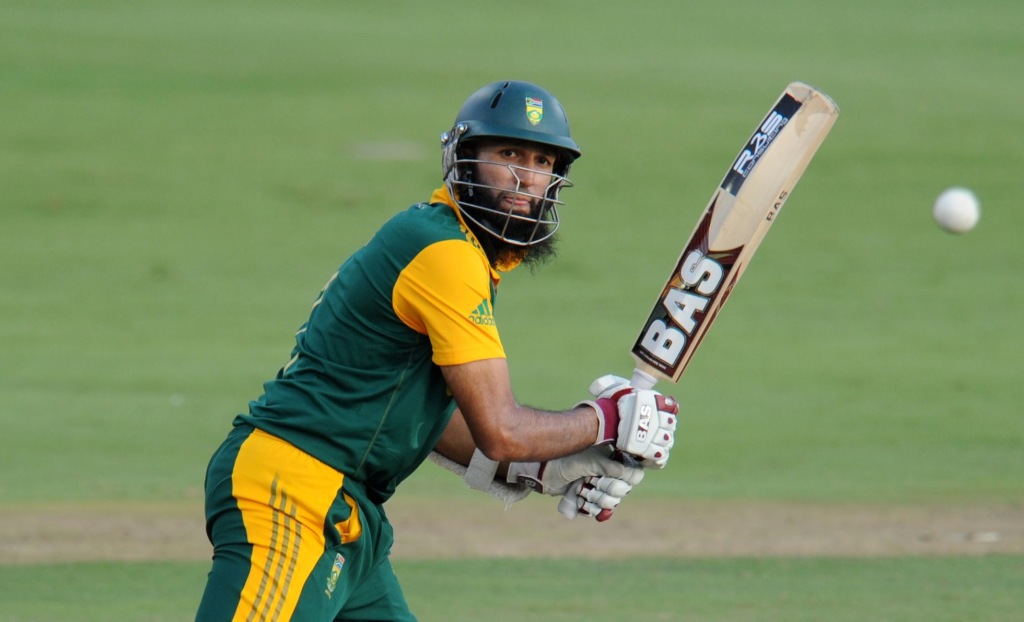Hashim Amla continues to break all manner of records and he proves himself to be one of the best ODI players of all time. Here we relook at what TOM EATON had to say about Amla in the December issue of Sunday Times/Business Day Sport Monthly.
Barring any major disasters, at some point in the next couple of months Hashim Amla will shatter Viv Richards’ record of – no, wait. ‘Shatter’ is too violent a word for Amla, a player who seems to embody the lightest and silkiest delights of the batting arts. Let us say, rather, that at some point fairly soon Amla is going to glide past the Antiguan as the fastest man to 5 000 runs in One-Day Internationals. A record set 27 years ago by the epitome of square-jawed, up-yours batting is going to be blown away like dandelion seeds on a breeze by the most unassuming of artists.
As Amla reaches the milestone of 100 ODIs and gets ready to usurp the Caribbean king, it seems appropriate to pause and have a little gush over South Africa’s unflappable superstar. But this isn’t a puff piece. Oh, hell no. Because if we’re going to be honest about Amla’s ODI career, we can’t hide from the fact that he’s pretty rubbish at four things.
The first of those things goes by the name of Mohammad Irfan and bowls pace out of his left hand for Pakistan. You will recall that Irfan is exceptionally tall, but exactly how tall he is remains a mystery: apparently Pakistani measuring tapes are as flexible as Pakistani birth certificates used to be, with the result that Irfan has been measured at 6ft 8in, 6ft 10in and 7ft 1in. But one man who hasn’t got the measure of him is Amla. Perhaps it’s the height (the ball is delivered from somewhere between the top of the sight-screen and the upper atmosphere, and comes down like a leather-covered meteorite), or perhaps it’s that pesky angle, sending the ball across Amla’s outside edge or turning him slightly chest-on. But whatever the reason, Amla seems to fall to Irfan uncommonly often. Indeed, as the giant seamer turns at the top of his run-up one might be forgiven for quoting another giant: ‘Fee fi fo fum, he smells the blood of a South African. Be Hash defending or on the attack, Irfan will soon be sending him back …’
The second problem Amla has is with run chases. I’m not saying he’s rotten at them, but at the time of writing he’d made 16 ODI hundreds and just three of them had been during chases. We know he doesn’t have a problem with pressure, so perhaps this is simply some unconscious petulance creeping into his game – the result of having the terms of his innings dictated to him by the game situation rather than walking out with 50 beautiful overs dangling in front of him, ripe for the plucking.
Thirdly, he’s not great against Australia. South African ODI stars of the mid-1990s would have killed to average 34 against the old foes, but by the somewhat bloated standards of the modern game, it’s a weak average.
OK. I admit it. Those first three flaws aren’t exactly fatal. After all, Irfan’s dominance over Amla might have just coincided with a wobble in the South African’s form. As for the weakness in chasing, well, the part I didn’t tell you was that he still averages 40 when chasing. Sure, it’s less than the 60 he manages setting a total, but you’d still take a guaranteed 40 most days. And the insipid record against Australia? That’s just a South African tradition.With the exception of Graeme Smith, South Africans have always saved their most hesitant cricket for series against Australia. So business as usual there …
The fourth weakness, however, can’t be glossed over. It is glaring, and involves something Amla seems completely incapable of doing. What is it? Taking credit. Stepping into the spotlight. Acknowledging our collective applause as he takes his place as the best ODI batsman since Sachin Tendulkar. For years it was Viv and Sachin. Now it’s Viv, Sachin and Hashim.
If you think I’m gilding the lily, consider the following: after 98 ODIs (Amla’s tally at the time of writing) he had scored 700 runs more than anyone else at the same point in their careers. Richards lay a distant second, Virat Kohli a close third, and then, almost 1 000 runs behind, Brian Lara. Tendulkar was nowhere, not yet having perfected his method at the top of the order. I know statistics are deceptive. I know ODIs in Viv Richards’ time were unrecognisably different from those played today. But you can’t get around the fact that, after 100 ODIs, Amla has scored at a rate unparallelled in the history of the game. It’s not as if he’s just squeaked past the likes of Richards and Lara. There’s Amla, then daylight, then everyone else.
What cements Amla’s class for me is the striking similarity between his method and that of Tendulkar. Like the Indian, Amla is an unflappable master with soft hands who would rather drive through mid-on than flick aerially over midwicket, and whose technique is tight without being restrictive. Like Tendulkar, he has been freed of the anxieties of the middle order where a soft ball and strategic complexities can muddy the waters. Opening the innings, he knows his only job is to use all his skill to guide a hard ball through a restricted field; and the results are spectacular. Tendulkar averaged 50 against the best ODI teams of his day (Australia, Pakistan, South Africa and Sri Lanka). Against the current top four (Australia, India, Pakistan and Sri Lanka), Amla averages – you guessed it – 50.
So if Amla is cutting a swathe through the record books and creating a legacy that can comfortably stand alongside two of the all-time greats, where are the banner headlines? Where are the awkward but good-natured cameos on television ads for hamburgers or cars or life insurance? Hell, even Jonty Rhodes managed to flog a line of chinos back in the mid-90s, with billboards featuring the fielding legend in a rather awkward horizontal pose, dressed in a shirt and slacks, as if he was running out Inzamam-ul-Haq near the office water-cooler. (Somehow red-blooded sports fans failed to realise that they were clamouring to get into Jonty’s pants. It was a simpler time …)
Perhaps Amla’s faith (or at least his well-defined principles) has persuaded him to avoid the earthly demands of publicity. He seems a genuinely modest and self-contained man, blessed with the kind of piety that manifests as humility rather than preachiness. He is the anti-Pietersen: a cricketer with a clear picture of the world he inhabits, at peace with his relatively small place in that world, with no demons in his head demanding that he turn the spotlight on himself again and again.
Then again, there have been other modest men who have been cricketing megastars. Many pundits are still trying to figure out how Tendulkar, a global sporting megastar, managed to keep his private life entirely out of the public eye and how he maintained his serene demeanour through two decades of spectacular success and unimaginable pressure. So perhaps modesty alone is no guarantee of a relatively low-key career.
One explanation might be Amla’s style of play. Had he debuted 20 years ago he might have got the same adulation Tendulkar did, lauded for the silkiness of his strokes and his astonishing ability to score quickly without ever seeming to hit the ball particularly hard. But the aesthetics of cricket have changed, and while sophisticated hedonists and Test aficionados still savour Amla’s artistry, most fans of the shorter formats want
to see balls flying through the night sky, soaring over jets of flame and high-kicking cheerleaders.
Here I must confess that even I, a stodgy traditionalist who believes cricket reached an apex in the early-2000s and has been somewhat drab since then, sometimes catch myself thinking of Amla as sedate. It shocked me to discover that Amla’s ODI strike rate was almost identical to Lance Klusener’s and forced me to concede that even I might have an unconscious preference for aerial sloggery over all-along-the-carpet class.
Charisma and aesthetics, however, are just footnotes in the larger explanation of why we have responded to Amla’s ODI heroics with a collective ‘meh’. The sad truth is that he could be twice as charming and hit the ball in the air twice as often and we’d still smile and nod politely. Why? Because ODIs are dead. Sure, we watch them, and we crank out a drop of adrenaline come World Cup time; but the truth, which we all feel in our cricketing marrow, is that the 50-over format was dead the moment T20 was from the ICC’s womb untimely ripp’d. We can watch Amla open an ODI innings for the Proteas and take pleasure in his mastery, but we cannot quite convince ourselves that it means anything, or at least anything relevant to modernity. Deep down we have to concede that being the third-best ODI batsman of all time is a little like being the third-best harpsichord-maker of all time. It takes vast skill and concentration, but it’s still, you know, a harpsichord.
Still, third-best-ever isn’t exactly chopped liver, and it’s tempting to look at that holy trinity of Viv, Sachin and Hashim and to dream of the heights Amla’s ODI career will still scale. How quickly will he reach 10 000 runs? Will he get to 15 000? Which apparently unattainable records will tumble to his educated blade? But these, unfortunately, must remain dreams.
In 2007 the World Cup in the Caribbean took an already stodgy format and turned it into a spectacle so tedious, so profoundly unwatchable, that for a few weeks it seemed that ODIs might be summarily executed. The 50-over game survived, but never fully recovered: 2007 was the high-water mark, with more ODIs played around the world than ever before; and then the slide began, with fewer and fewer high-profile teams playing fewer and fewer ODIs.
Even if the format survives, kept on life support by the World Cup, the numbers will continue to decline. Once, players could bank on 30 ODIs a year. No longer. The days of being able to rack up 10 000 runs in a limited-overs career are ending. Amla has at least four more years of ODI glory in him; perhaps another 3 000 runs. But when he calls time on his career he won’t be anywhere near the top of the all-time lists. Perhaps that’s a good thing.
The 50-over game was killed by quantity supplanting quality so maybe it’s fitting that its greatest post-Tendulkar exponent doesn’t end his career among the run-gluttons of the early-2000s, those players who endlessly gorged on meaningless cricket.
Soon our focus will turn to the World Conference of Harpsichord-Makers in Australia and New Zealand. We will watch the world’s ODI teams plane, hammer, screw, and tune their harpsichords, and, despite being intrigued now and then, we might struggle to take it all very seriously. Still, it would be nice if we could pause for a moment and rise to applaud the third-best harpsichord-maker of all time. Thank you, Mr Amla, for your beautiful craft. And here’s to a little more sweet music.
Up to and including the World Cup match against Pakistan, Amla had played 112 ODIs and scored 5 654 runs, including being the fastest man to 20 ODI centuries.







